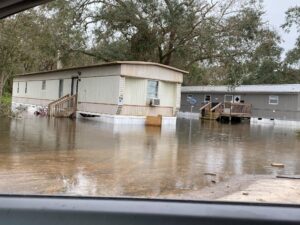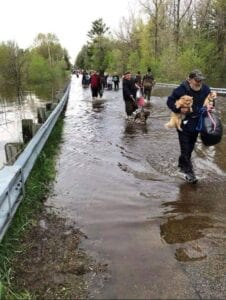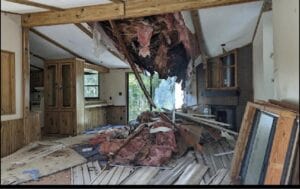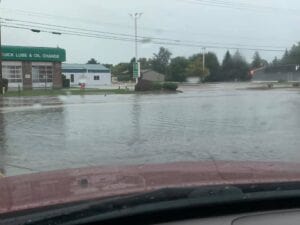Did you know that mobile homes are highly susceptible to flood damage? Floods can wreak havoc on these structures, causing extensive destruction. That’s why it is crucial to prioritize the protection of mobile homes from such catastrophic events. Ensuring the safety and well-being of residents is paramount. In this article Mobile Home Flood Protection we will discuss what you need to do to prepare for a flood.
Mobile Home Flood Protection
Floods have the potential to devastate not only the physical structure of a mobile home but also the lives of those who call it home. With rising sea levels and unpredictable weather patterns, safeguarding these dwellings has become more vital than ever before. By implementing preventive measures and investing in flood protection systems, we can minimize the risks associated with flooding.

Protecting our mobile homes from floods is not just about preserving property; it’s about safeguarding lives. So let’s take a closer look at how we can shield these vulnerable structures from the destructive forces of nature.
Mobile Home Residents Face Higher Flood Risk
Living in a mobile home comes with its own set of challenges, and one of the most significant risks faced by mobile home residents is flooding. Compared to those living in traditional houses, mobile home residents are at a higher risk of experiencing water intrusion during natural disasters such as floods. This elevated risk necessitates proactive measures to mitigate potential flood damage and ensure the safety of these vulnerable homeowners.
Mobile homes, also known as manufactured homes, are particularly susceptible to flooding due to their construction and location. These structures are typically built on low-lying areas or near bodies of water, making them more prone to floodwaters entering the premises. Many mobile homes lack proper foundations or anchoring systems, which can further increase their vulnerability to flooding.
Increased Flood Risk: Mobile Home Residents
The increased flood risk faced by mobile home residents highlights the importance of understanding their unique circumstances for effective flood preparedness. Recognizing that these homeowners are at a heightened risk allows communities and authorities to develop targeted strategies to minimize damage and protect lives.
One key consideration in addressing this issue is improving the resilience of mobile home parks located in high-risk flood areas. Implementing better infrastructure and drainage systems within these communities can help divert excess water away from residences, reducing the chances of flooding. Educating mobile home owners about appropriate insurance coverage for flood-related damages is crucial so that they can be adequately protected financially in case disaster strikes.
Furthermore, community members should be encouraged to take proactive steps towards safeguarding their homes against floods. This may include elevating their mobile homes above ground level or installing barriers such as sandbags around their properties during times of heavy rainfall or when local authorities issue flood warnings. Regular maintenance checks should also be conducted on roofs, windows, and doors to ensure they are watertight and less likely to allow water penetration.
Affordable Housing in Flood Areas
Local governments should prioritize affordable housing options for those living in vulnerable areas prone to flooding. By providing alternative housing solutions that are less susceptible to water damage, such as elevated or flood-resistant structures, the risk faced by mobile home residents can be significantly reduced. This approach not only protects the homeowners but also ensures that affordable housing remains accessible for all.
Assessing Flood Damage in Mobile Homes
After a flood, it is crucial to assess the extent of damage inflicted on mobile homes promptly. Conducting thorough assessments helps determine the necessary repairs and restoration efforts required. Accurate assessment of flood damage assists in estimating costs and expediting recovery processes.
Mobile homes are particularly vulnerable to flood damage due to their lightweight construction and proximity to water bodies. When a flood occurs, it can wreak havoc on these structures, leading to structural issues, electrical problems, and mold growth. To effectively assess the damage caused by a flood in a mobile home, the following steps should be taken:
Safety first: Before entering a flooded mobile home for assessment purposes, ensure that it is safe to do so. Turn off all utilities such as electricity, gas, and water to avoid potential hazards. Wear protective gear like gloves and boots as floods can introduce harmful contaminants into the living space.
Visual inspection: Begin by visually examining the interior and exterior of the mobile home. Look for signs of structural damage such as cracks in walls or floors, warped materials, or shifted foundations. Pay close attention to areas where water may have entered or pooled.
Electrical systems: Check the electrical system thoroughly as exposure to water can cause short circuits or other electrical hazards. Inspect outlets, switches, wiring, and appliances for any visible signs of water damage or malfunctioning.
This List Is Long But It Could Save You During Mobile Home Floods
Plumbing evaluation: Assess the plumbing system for leaks or pipe damages that may have occurred during the flood. Look for signs of water stains on walls or ceilings indicating hidden leaks behind them.
Mold inspection: Floods create ideal conditions for mold growth due to prolonged moisture exposure. Inspect all areas susceptible to mold infestation such as basements, crawl spaces, bathrooms, and kitchens. Look out for visible mold growth or musty odors which indicate its presence.
Documenting damages: Take photographs or videos of the flood damage to provide evidence for insurance claims or assistance programs. Make detailed notes of all the areas affected and the extent of the damage. This documentation will aid in estimating repair costs accurately.
These Steps Can Save You: Mobile Home Flood Protection
Professional assessment: Consider seeking professional help from a licensed contractor or inspector experienced in assessing flood damage in mobile homes. Their expertise can uncover hidden issues and provide a comprehensive evaluation.
Prioritize repairs: Based on the assessment, prioritize repairs according to urgency and safety concerns. Address structural issues first to ensure the stability of the mobile home before focusing on cosmetic repairs.
Restoration efforts: Once you have assessed the damage and determined necessary repairs, begin restoration efforts promptly to prevent further deterioration and mold growth. Follow recommended guidelines for drying out the mobile home thoroughly before initiating any repairs.
Assessing flood damage in mobile homes is crucial for efficient recovery processes. By following these steps, you can identify issues, estimate costs accurately, and expedite necessary repairs, ensuring that your mobile home recovers from a flood effectively.
Restoring Flood-Damaged Mobile Homes
Restoring flooded mobile homes involves comprehensive cleaning, drying, and repair procedures. When a mobile home is affected by flooding, it is crucial to take immediate action to mitigate further damage and ensure the safety of its occupants. Water damage restoration in manufactured homes requires specialized knowledge and equipment to restore structural integrity and create a safe living environment.

Timely restoration efforts are essential to prevent further deterioration and minimize health risks associated with water damage. The longer the water remains stagnant in the home, the greater the risk of mold growth, which can lead to respiratory issues and other health problems. By promptly addressing the flood damage, homeowners can significantly reduce these risks.
To begin the restoration process for flood-damaged mobile homes, it is vital to remove all standing water as quickly as possible. This can be achieved through the use of water extraction systems that efficiently remove excess moisture from floors, walls, and furniture. Restoration companies equipped with powerful dehumidifiers and air scrubbers play a critical role in eliminating excess moisture from the air and preventing mold growth.
Once all visible water has been extracted, thorough cleaning is necessary to eliminate any remaining contaminants. Cleaning agents specifically formulated for water damage restoration should be used to disinfect surfaces and remove any traces of bacteria or mold that may have developed during the flooding.
Repairing Structural Components: Mobile Home Floods
Repairing structural components damaged by floodwaters is another crucial step in restoring mobile homes after a flood event. This may involve replacing damaged drywall, insulation, flooring materials, or even repairing electrical systems that have been compromised by water infiltration. Seeking professional assistance from experienced contractors ensures that repairs are carried out correctly and up to code.
In addition to structural repairs, ensuring proper ventilation throughout the restored mobile home is essential for preventing future moisture-related issues. Proper airflow helps maintain optimal humidity levels inside the home and reduces the likelihood of mold re-growth.
To enhance resilience against future floods or disasters, homeowners should consider implementing preventive measures such as elevating the mobile home, installing flood barriers, or improving drainage systems around the property. These proactive steps can help minimize potential damage in the event of future flooding.
Eligibility for Flood Insurance Coverage
Homeowners residing in designated high-risk areas may be eligible for federally backed flood insurance coverage. Understanding eligibility criteria is important when considering obtaining adequate insurance protection against floods. Exploring available options ensures that homeowners make informed decisions regarding their coverage needs.
Having the right insurance coverage is crucial. Flooding can cause extensive damage to your property and belongings, leaving you with hefty repair and replacement costs. That’s where flood insurance comes in.
Who is eligible for flood insurance coverage?
To determine if you are eligible for flood insurance coverage, it’s essential to understand the criteria set by the National Flood Insurance Program (NFIP) and private insurers. Here are some key factors that influence eligibility:
Flood Risk: Homeowners residing in high-risk flood zones have a higher likelihood of being eligible for flood insurance coverage. These areas are prone to frequent flooding due to their proximity to bodies of water or historical flooding patterns.
Federal Emergency Management Agency (FEMA) Designations: FEMA designates certain areas as Special Flood Hazard Areas (SFHAs), which indicates a high risk of flooding. If your property falls within an SFHA, you will likely qualify for federally backed flood insurance through the NFIP.
Mandatory Requirements: In some cases, mortgage lenders may require homeowners in high-risk areas to carry flood insurance as a condition of receiving a loan.
Private Flood Insurance: Apart from the NFIP, private insurers also offer flood insurance policies with varying eligibility requirements and coverages. It’s worth exploring these options if you don’t meet the criteria set by the NFIP or seek additional coverage beyond what they provide.

You might also be interested in our article:
Fast & Reliable WIFI for Mobile Homes: 5g Home Internet Plans
Understanding Flood Insurance Options
Obtaining comprehensive flood insurance requires careful consideration of available options. By comparing different policies and rates, homeowners can make informed decisions about their coverage needs. Here are some aspects to consider:
NFIP Coverage: The NFIP offers flood insurance policies that cover both the structure and contents of your home. It’s important to understand the coverage limits, deductibles, and exclusions associated with these policies.
Private Insurance Policies: Private insurers often provide additional options for flood insurance coverage. These policies may offer higher coverage limits or additional benefits not available through the NFIP. Comparing flood insurance rates from different private insurers can help homeowners find a policy that suits their specific requirements.
Flood Service Providers: Some companies specialize in offering flood insurance services and can assist homeowners in understanding their options, comparing rates, and choosing the right policy.
The Importance of Adequate Flood Insurance
Flooding can lead to significant damage to your home and belongings, causing financial distress if you’re not adequately insured. By assessing your property’s flood risk and exploring available options, you can ensure that you have sufficient coverage in place.
Remember, don’t rely solely on standard home insurance policies as they typically do not cover flood damage. Instead, invest in dedicated flood insurance coverage that specifically addresses this risk.
Understanding Mobile Home Flood Protection: Insurance Coverage
Mobile home owners should familiarize themselves with specific provisions related to their flood insurance policies. This is crucial for ensuring that they have adequate financial protection in the event of a flood. By understanding policy details such as coverage limits, deductibles, and exclusions, homeowners can make informed decisions and be prepared for any potential flooding risks.

Having mobile home insurance is essential for protecting your investment. However, it’s important to note that standard mobile home insurance policies typically do not cover flood damage. To safeguard against this specific risk, homeowners need to obtain separate flood insurance coverage.
There are several key aspects to consider:
Coverage Limits
Understanding the coverage limits of your policy is vital in determining how much financial protection you have in the event of a flood. Different policies may offer varying levels of coverage, so it’s essential to review and assess your options carefully. Make sure you have sufficient coverage to repair or replace your mobile home and its contents if they are damaged by flooding.
Deductibles: Mobile Home Flood Protection
Just like other types of insurance, flood insurance policies also come with deductibles. This is the amount you must pay out-of-pocket before your coverage kicks in. It’s important to be aware of your deductible amount and factor it into your budget when considering flood insurance options. Keep in mind that higher deductibles often result in lower premium costs but may require more significant upfront expenses if a claim needs to be filed.
Exclusions: Mobile Home Flood Protection
Exclusions refer to specific circumstances or items that are not covered by your policy. It’s crucial to carefully review these exclusions to understand what types of damage might not be eligible for reimbursement under your flood insurance policy. Common exclusions may include damages caused by sewer backups or water seepage through foundations.
Mobile Home Flood Protection and Claims
Navigating the claims process effectively requires clear comprehension of policy terms and requirements:
Review Policy Details: Familiarize yourself with the specific terms and conditions outlined in your mobile home flood insurance policy. Pay close attention to any deadlines for filing claims or providing documentation.
Document Damage: If your mobile home experiences flood damage, document the extent of the destruction by taking photographs or videos. This evidence will help support your claim and ensure you receive appropriate compensation.
Contact Your Insurance Provider: As soon as possible, contact your insurance provider to report the flood damage and initiate the claims process. Provide them with all necessary information and documentation to expedite the assessment of your claim.
Work with Adjusters: Expect an insurance adjuster to visit your property to assess the damages and determine the coverage amount. Cooperate fully during this process, providing any additional information or evidence they may require.
Keep Records: Throughout the claims process, keep detailed records of all communication with your insurance provider, including dates, times, and names of individuals involved. This will help ensure a smooth process if any issues arise.
By understanding mobile home flood insurance coverage provisions thoroughly, homeowners can protect their investment against potential financial losses caused by flooding events. Familiarizing yourself with coverage limits, deductibles, exclusions, and navigating the claims process will provide peace of mind knowing that you have taken proactive steps to safeguard your mobile home from flood-related risks.
Impact of floods on mobile homes: black mold, rot, and structural damage
Floods can have devastating consequences for mobile homes, leading to the growth of black mold, rotting of materials, and compromising their structural integrity. The effects of these natural disasters go beyond visible damage, necessitating comprehensive restoration efforts.
Black Mold: A Health Risk to Occupants
One of the major concerns following a flood in a mobile home is the growth of black mold. Excessive moisture from flooding creates an ideal environment for mold spores to thrive. These spores can quickly spread throughout the structure, posing serious health risks to occupants.
Mold exposure can cause respiratory issues such as coughing, wheezing, and nasal congestion. Individuals with allergies or asthma are particularly vulnerable to these symptoms. Prolonged exposure may even lead to more severe health problems. It is crucial to address any signs of black mold in a timely manner to protect the well-being of those living in the mobile home.
Rotting Materials: Compromised Structural Integrity
Mobile homes are often constructed using porous materials that are susceptible to water damage. When exposed to hard rain or flooding, these materials absorb excessive moisture, leading to rotting.
The presence of rot compromises the structural integrity of the mobile home. Over time, weakened materials may result in sagging floors or walls and even potential collapse if left unaddressed. It is essential for homeowners affected by floods to thoroughly inspect their mobile homes for signs of rot and take prompt action before further deterioration occurs.
To mitigate this risk after a flood:
Remove any wet carpeting or flooring.
Dry out affected areas using fans and dehumidifiers.
Inspect walls and ceilings for dampness or discoloration.
Replace damaged insulation or drywall.
Seek professional assistance if extensive repairs are necessary.
Comprehensive Restoration Efforts: Mobile Home Flood Protection
The impact of floods on mobile homes extends far beyond the visible damage caused by black mold and rot. It is crucial to undertake comprehensive restoration efforts to ensure the safety and habitability of the structure.
Restoration may involve:
Removing damaged materials, including drywall, insulation, and flooring.
Thoroughly cleaning and disinfecting all surfaces affected by mold growth.
Conducting structural repairs to address any compromised areas.
Implementing preventive measures such as improved drainage systems or elevated foundations.
By taking these steps, homeowners can restore their mobile homes to a safe condition after a flood.
Conclusion: Mobile Home Flood Protection
Dealing with floods in mobile homes can be a challenging and overwhelming experience. Mobile home residents face a higher flood risk compared to those living in traditional houses. Assessing the damage caused by floods is crucial in order to determine the necessary steps for restoration. Restoring flood-damaged mobile homes requires prompt action and professional assistance.
Understanding eligibility for flood insurance coverage is essential for mobile home owners. It is important to comprehend the specifics of mobile home flood insurance coverage to ensure adequate protection against potential damages. Floods can have a severe impact on mobile homes, leading to issues such as black mold, rot, and structural damage.
To effectively deal with floods in mobile homes, it is crucial to take immediate action and seek professional help when needed. The presence of black mold, rot, or structural damage should not be taken lightly as they can pose serious health risks and compromise the integrity of the home.
Final Thoughts: Mobile Home Flood Protection
In order to protect your investment and mitigate potential losses from flooding, obtaining proper flood insurance coverage for your mobile home is highly recommended. Understanding the terms and conditions of your policy will help you navigate through any potential claims process smoothly.
Remember that prevention is key. Taking proactive measures such as elevating your home or installing flood barriers can significantly reduce the risk of damage during a flood event.
In conclusion, being well-informed about how to handle floods in mobile homes is essential for every resident. By understanding the risks involved, assessing damages accurately, restoring affected areas promptly, and securing appropriate insurance coverage, you can protect yourself from significant financial losses and ensure the safety of your family.
FAQs: Mobile Home Flood Protection
How do I assess if my mobile home has suffered flood damage?
Look out for signs such as water stains on walls or ceilings, warped flooring or subflooring, musty odors or visible mold growth inside the home. It’s advisable to consult a professional for a thorough inspection.
Can I restore my flood-damaged mobile home by myself?
While minor repairs and cleanup can be done independently, it is recommended to seek professional assistance for major restoration work. They have the expertise and equipment necessary to ensure proper restoration and minimize further damage.
Will my mobile home insurance cover flood damages?
Standard mobile home insurance policies typically do not cover flood damage. You will need a separate flood insurance policy to protect your home against floods. It’s important to review your policy details or consult with an insurance agent to understand your coverage options.
How long does it take to restore a flood-damaged mobile home?
The duration of restoration depends on the extent of the damage. Minor repairs may take a few days, while significant structural repairs could take weeks or even months. It’s best to consult with professionals who can provide an accurate estimate based on your specific situation.
Are there any government programs that provide assistance for flood-damaged mobile homes?
Yes, there are government programs like FEMA’s Individual Assistance program that may provide financial aid for eligible individuals affected by floods. It’s advisable to check with local authorities or visit FEMA’s website for more information on available assistance programs.
You might also be interested in our articles:
Secure Your Mobile Home with Hurricane Tie-Downs
